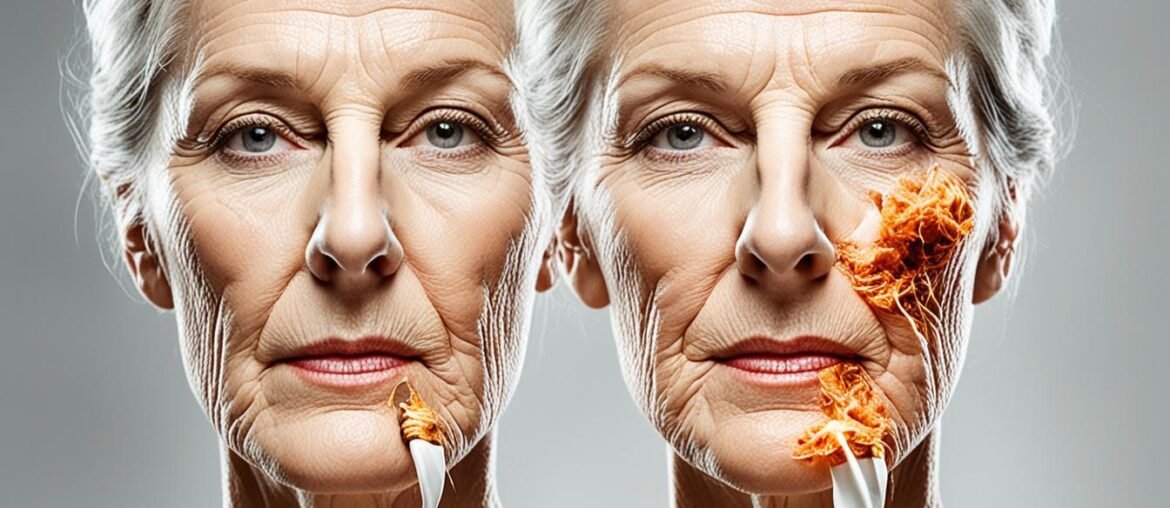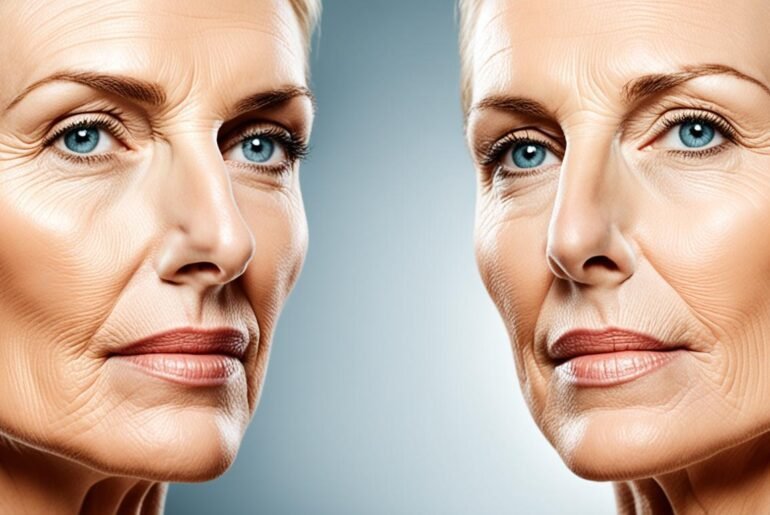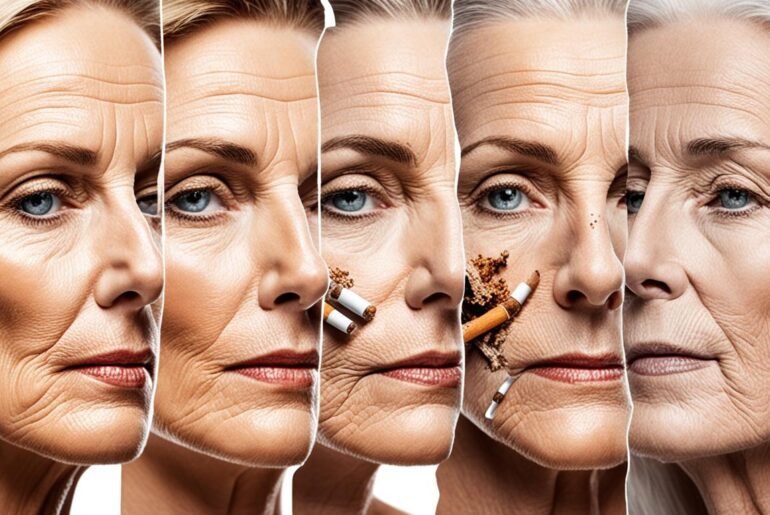Did you know that smoking is not only detrimental to your lungs but also to your skin? In fact, studies have shown that smoking is a significant environmental factor in premature skin aging. The impact of smoking on your appearance goes beyond just wrinkles and aging, extending to a range of dermatological conditions such as poor wound healing, skin cancer, acne, psoriasis, and even hair loss.
If you’re curious about how smoking affects your skin health and what you can do to reverse the damage, keep reading. In this article, I will explore the effects of smoking on the skin, the mechanisms behind smoking-related wrinkles, and whether quitting smoking can actually reverse these effects. I will also provide valuable tips on skincare for smokers and resources to help you quit smoking for good.
Key Takeaways:
- Smoking is a significant environmental factor in premature skin aging.
- It can lead to a range of dermatological conditions, including poor wound healing, skin cancer, acne, and psoriasis.
- Smoking reduces blood flow to the skin, breaks down collagen and elastin, and limits the skin’s oxygen and nutrient supply.
- Quitting smoking can improve collagen levels and reverse certain aspects of skin damage.
- Adopting a balanced diet, practicing a skincare routine, and avoiding alcohol and caffeine can also aid in reversing the effects of smoking on the skin.
Effects of Smoking on Skin Health
Smoking can have detrimental effects on the health of your skin. As a smoker, you may experience skin damage, premature aging, and various other skin-related concerns.
One of the ways smoking affects the skin is by decreasing blood flow to skin cells. This reduction in blood flow restricts the delivery of oxygen and essential nutrients to the skin, resulting in reduced skin health and vitality.
In addition, smoking can lead to a decrease in moisture levels in the dermis, the deeper layer of the skin. This loss of moisture results in dryness and dullness, making your skin appear lackluster and unhealthy.
Perhaps one of the most concerning effects of smoking on the skin is the breakdown of collagen and elastin. Collagen and elastin are two proteins responsible for maintaining the skin’s structure and elasticity. Smoking can accelerate the degradation of these proteins, leading to the formation of wrinkles and fine lines. Furthermore, smokers tend to have lower levels of collagen and elastin compared to non-smokers, which contributes to premature aging.
By quitting smoking, you can stop the development of wrinkles and potentially reverse some of the damage caused by smoking. Research suggests that when you quit smoking, your body can gradually repair and regenerate skin cells, improving the overall health and appearance of your skin.
It’s important to prioritize your skin health by quitting smoking and adopting healthy lifestyle habits. Not only will quitting smoking benefit your skin, but it will also have a positive impact on your overall well-being.
| Effects of Smoking on Skin Health |
|---|
| Decreased blood flow to skin cells |
| Reduced moisture in the dermis |
| Breakdown of collagen and elastin |
| Formation of wrinkles and fine lines |
| Premature aging |
Mechanisms Behind Smoking-Related Wrinkles
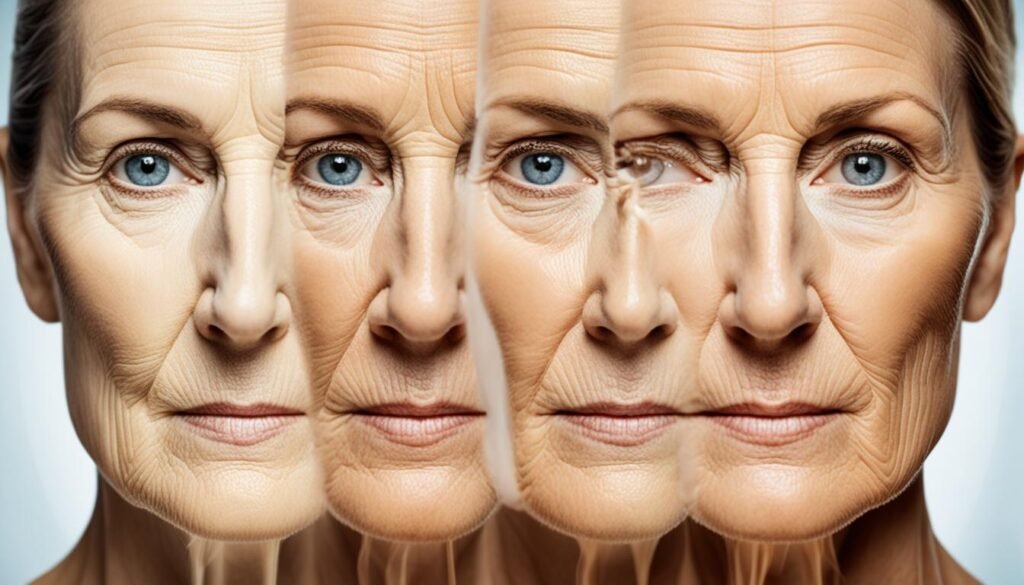
Smoking has detrimental effects on the skin, particularly in relation to wrinkles and premature aging. Let’s explore the mechanisms behind smoking-related wrinkles.
Firstly, smoking contributes to collagen breakdown, which is a key component of skin elasticity. Collagen provides structure and firmness to the skin, but smoking inhibits its production, leading to sagging and the formation of wrinkles.
The act of smoking itself can also contribute to the development of wrinkles. The repetitive motion of sucking on a cigarette can result in the formation of lines around the mouth, commonly known as smoker’s lines. Additionally, the act of squinting due to smoke irritation can lead to wrinkles around the eyes.
Furthermore, smoking has a vasoconstrictive effect, causing the blood vessels in the skin to narrow. This reduces the blood supply to the skin, depriving it of oxygen and essential nutrients. As a result, the skin becomes more susceptible to damage and aging, leading to the formation of wrinkles.
Overall, smoking accelerates the natural aging process of the skin, causing it to lose its elasticity and develop wrinkles. It is important to be aware of these mechanisms and the impact of smoking on the skin’s health and appearance.
Can Quitting Smoking Reverse Wrinkles?
Studies suggest that quitting smoking can improve collagen levels and reverse certain aspects of skin damage. Former smokers have shown improved collagen production within weeks of quitting, and age spots and hyperpigmentation can reverse within a month of quitting. While complete reversal of smoking-related wrinkles may not occur, increased collagen can make them less visible.
When you quit smoking, your body starts to repair itself. The first visible signs of improvement can be seen in the skin. The increased collagen production helps to plump up the skin, reducing the appearance of wrinkles. Research has shown that even long-term smokers who quit smoking can experience significant improvement in their skin’s condition.
Quitting smoking is like pressing the reset button for your skin. It’s never too late to start, and the benefits will be noticeable.
One study published in the Journal of the American Medical Association (JAMA) Dermatology found that former smokers had skin that was nearly indistinguishable from that of individuals who had never smoked. The study participants showed a 25% improvement in collagen production after quitting smoking for nine months.
Another study conducted in Germany found that age spots and hyperpigmentation in former smokers can improve by 64% within four weeks of quitting. The improvement continued over time, with a 73% reduction in age spots after six months of smoking cessation.
The Impact of Quitting Smoking on Wrinkle Reduction
A study published in the Annals of Internal Medicine followed 64 women who underwent high-resolution ultrasound imaging to determine the effects of quitting smoking on their skin. The results showed that within 12 months of quitting smoking, the participants experienced a 16% increase in skin thickness and a 41% reduction in wrinkle severity.
These findings indicate that quitting smoking can have a significant impact on improving skin health and reducing the visible signs of aging, such as wrinkles.
| Effects of Quitting Smoking on Wrinkles | Timeline |
|---|---|
| Increase in collagen production | Within weeks |
| Reduction in age spots and hyperpigmentation | Within a month |
| Increase in skin thickness | Within 12 months |
| Reduction in wrinkle severity | Within 12 months |
While it may take time for the skin to fully recover from the effects of smoking, quitting smoking is a crucial step in improving skin health and reducing the visible signs of aging. The benefits of quitting smoking extend beyond just the skin, contributing to overall health and well-being.
Skin Care Tips for Smokers
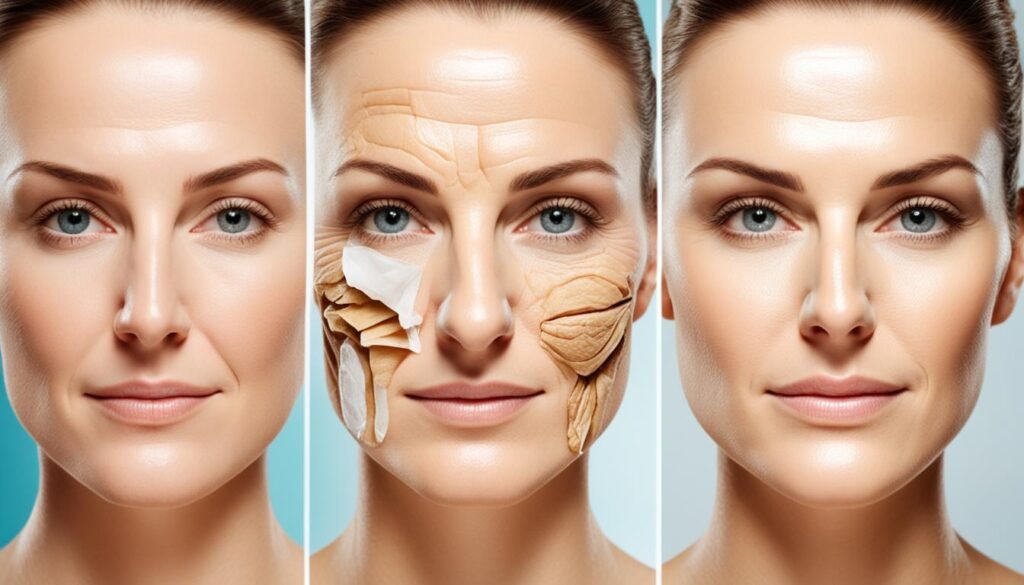
As a smoker, taking steps to reverse the effects of smoking on your skin is essential for maintaining its health and appearance. While quitting smoking is the most effective way to improve your skin’s condition, there are other measures you can take to support the process.
Adopt a Balanced Diet
One of the key factors in reversing smoking effects on the skin is nourishing your body from within. A diet rich in vitamins and minerals can help restore skin health and repair damage caused by smoking. Incorporate foods that are high in antioxidants, such as fruits, vegetables, and whole grains, into your daily meals.
Get Regular Exercise
Regular physical activity not only benefits your overall health but also promotes blood circulation, which is vital for healthy skin. Engage in aerobic exercises like running, swimming, or cycling to increase blood flow to your skin cells. This can help nourish the skin and improve its appearance.
Prioritize Sleep
A good night’s sleep is essential for skin rejuvenation. While you sleep, your body repairs damaged cells, including those affected by smoking. Aim for 7-9 hours of quality sleep each night to allow your skin to heal and regenerate.
Use Sunscreen
Protecting your skin from further damage is crucial in the journey of reversing smoking effects. Apply a broad-spectrum sunscreen with SPF 30 or higher every day, even on cloudy days. This will shield your skin from UVA and UVB rays, which can exacerbate skin aging and increase the risk of skin cancer.
Maintain a Proper Skincare Routine
Establishing a consistent skincare routine can help repair and nourish your skin. Cleanse your skin twice a day with a gentle cleanser to remove impurities. Use moisturizers that are suitable for your skin type to hydrate and protect the skin barrier. Incorporate products with ingredients like retinol, vitamin C, and hyaluronic acid to target wrinkles and promote collagen production.
Consider In-Office Treatments
Professional treatments can further enhance the effects of your skincare routine. Consult a dermatologist or aesthetician for options such as chemical peels, microdermabrasion, or laser therapies. These treatments can help stimulate collagen production, reduce wrinkles, and improve overall skin texture and appearance.
Avoid Alcohol and Caffeine
Alcohol and caffeine can dehydrate the skin and exacerbate the effects of smoking. Limit your consumption of alcoholic beverages and caffeinated drinks to prevent further damage to your skin. Instead, opt for hydrating alternatives like water, herbal tea, or fresh juices.
By incorporating these skin care tips into your routine, you can help reverse the effects of smoking on your skin. Remember, quitting smoking is the most crucial step towards improving your skin’s health and appearance. With a combination of lifestyle changes and proper skincare, you can regain a healthier, more vibrant complexion.
The Effects of Smoking on Wound Healing and Psoriasis
https://www.youtube.com/watch?v=c3DmVo3HO9I
Smoking has detrimental effects on wound healing and can exacerbate the symptoms of psoriasis, an inflammatory skin condition. Let’s explore how smoking hampers the healing process and worsens psoriasis.
The Impact on Wound Healing
When it comes to wound healing, smoking has a profound negative impact. The reduced blood supply caused by smoking constricts blood vessels, limiting oxygen and vital nutrients from reaching the wound site. This lack of oxygen and nutrients severely hampers the body’s natural healing process, delaying wound closure and increasing the risk of developing infections.
Furthermore, smoking diminishes collagen production, a crucial protein for skin regeneration and wound closure. Collagen provides structural integrity to the skin and aids in the formation of new tissue. The impaired collagen production associated with smoking inhibits proper wound healing and can result in the formation of weak, fragile scars.
| Effects of Smoking on Wound Healing | |
|---|---|
| 1 | Delayed wound closure |
| 2 | Increased risk of infections |
| 3 | Poor collagen production |
| 4 | Weaker, fragile scars |
The Link to Psoriasis
In addition to its impact on wound healing, smoking is also closely associated with psoriasis. Psoriasis is a chronic autoimmune disease that leads to the rapid overproduction of skin cells, causing red, scaly patches to appear on the skin.
Studies show that smokers have a higher risk of developing psoriasis compared to non-smokers. The exact mechanisms behind this association are not completely understood, but it is believed that the chemicals present in tobacco smoke trigger an inflammatory response in the skin, leading to the development and exacerbation of psoriasis symptoms.
“Smoking worsens wound healing and increases the risk of infections. It also exacerbates the symptoms of psoriasis, an inflammatory skin condition.”
It is important to note that smoking not only impacts the skin externally but also affects the immune system, further contributing to the development and progression of psoriasis. Quitting smoking is crucial for managing psoriasis symptoms and reducing flare-ups.
By understanding the detrimental effects of smoking on wound healing and psoriasis, individuals can make informed decisions to quit smoking and prioritize their skin health.
Importance of Quitting Smoking for Skin Health
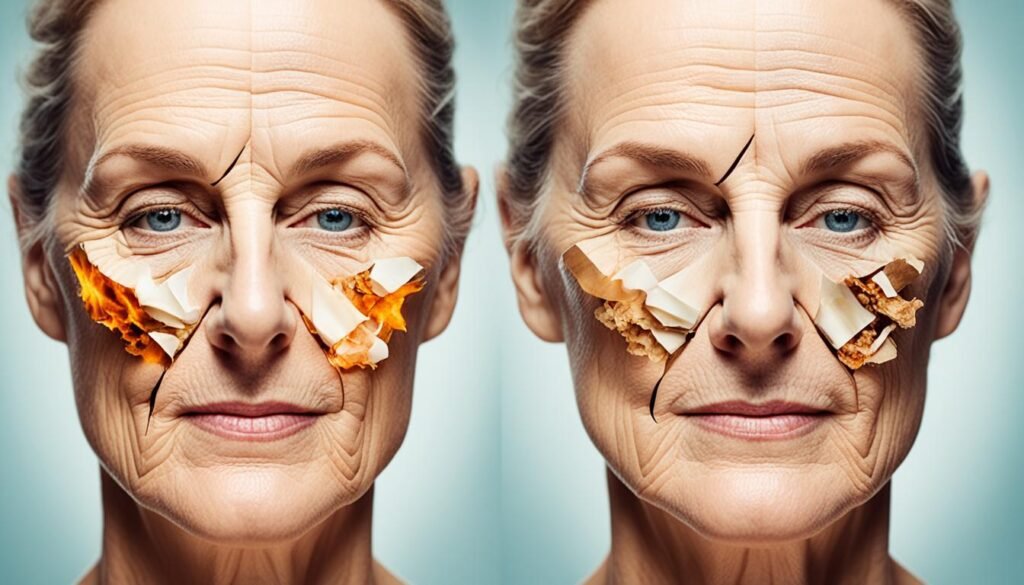
Smoking’s effects on the skin may not be life-threatening, but they can have a significant impact on your appearance and overall skin health. Quitting smoking plays a crucial role in preventing premature aging, sagging, and the development of wrinkles.
When you smoke, the chemicals in tobacco smoke constrict blood vessels, reducing blood flow and oxygen supply to the skin. This limited blood flow deprives the skin of essential nutrients, resulting in a dull and unhealthy complexion. Additionally, smoking damages collagen and elastin fibers, which are responsible for maintaining skin elasticity and firmness. This breakdown of collagen and elastin leads to sagging and the formation of wrinkles.
By quitting smoking, you allow your skin to rejuvenate and repair itself. Quitting smoking can increase blood flow to the skin, improving oxygen and nutrient supply and promoting a healthier complexion. It can also help your skin regain its elasticity and reduce the visibility of wrinkles.
The Benefits of Quitting Smoking for Skin Health
Quitting smoking not only improves the appearance of your skin but also has numerous other benefits for skin health:
- Improved wound healing: Smoking impairs the healing process of wounds and increases the risk of infections. Quitting smoking enhances the body’s natural healing abilities, reducing the risk of complications during the healing process.
- Reduced risk of infections: Smoking weakens the immune system, making the skin more susceptible to infections. By quitting smoking, you boost your immune system and reduce the risk of developing skin infections.
- Alleviated symptoms of psoriasis: Psoriasis is an inflammatory skin condition that can be exacerbated by smoking. Quitting smoking can help improve the symptoms of psoriasis, reducing redness, scaling, and discomfort.
Quitting smoking not only improves your skin health but also has a positive impact on your overall well-being. It reduces the risk of various diseases, including cancer and heart disease, improves lung function, and enhances your overall quality of life.
Make the decision to quit smoking today and experience the benefits it brings to your skin and overall health.
Resources for Quitting Smoking

If you’re ready to quit smoking and improve your skin health, there are various resources available to support you in your journey. These resources can provide the tools, guidance, and encouragement you need to successfully quit smoking for good. Here are some valuable quitting smoking resources:
- Nicotine Replacement Therapy: Products like nicotine patches, gum, and inhalers can help reduce nicotine cravings and ease withdrawal symptoms.
- Support Groups and Counseling: Joining a support group or seeking counseling can provide you with a network of individuals who are going through the same challenges. These groups offer valuable advice, encouragement, and a safe space to share your experiences.
- Quitline Services: Many countries offer dedicated quitlines that provide free phone assistance to help individuals quit smoking. Trained professionals are available to offer personalized support and advice.
- Mobile Apps: There are numerous mobile apps designed to help individuals quit smoking. These apps provide features such as tracking progress, offering motivational messages, and providing tips and resources.
By combining your own willpower with these valuable resources, you can increase your chances of successfully quitting smoking and improving your skin health.
The Bottom Line
Smoking is a preventable cause of premature skin aging, wrinkles, and various dermatological conditions. While quitting smoking may not completely reverse all skin damage, it can improve collagen production, reduce the visibility of wrinkles, and enhance overall skin health.
In addition to quitting smoking, adopting a balanced diet, getting regular exercise, practicing a good skincare routine, and considering in-office treatments can further aid in reversing the effects of smoking on the skin.
| Benefits of Quitting Smoking for the Skin |
|---|
| Improved collagen production |
| Reduction in the visibility of wrinkles |
| Enhanced overall skin health |
| Decreased risk of dermatological conditions |
Quitting smoking is not only beneficial for your overall health but also for your skin. It can lead to improvements in collagen production, reduction in the appearance of wrinkles, and overall enhancement of skin health. By adopting healthy habits and seeking professional treatments, you can further reverse the effects of smoking on your skin.
Conclusion
Quitting smoking is crucial for maintaining skin health and preventing premature aging. The harmful effects of smoking on the skin, including wrinkling, sagging, and poor wound healing, highlight the need to prioritize smoking cessation.
When you quit smoking, you not only reduce your risk of developing wrinkles, but you also improve your overall skin health. Smoking restricts blood flow to the skin, limiting the delivery of essential nutrients and oxygen. This can lead to a decrease in collagen and elastin, resulting in premature aging. By quitting smoking, you allow your skin to regain its natural glow and elasticity.
However, quitting smoking is just the first step. It is essential to adopt healthy lifestyle habits to maintain and improve your skin health. This includes following a balanced diet, exercising regularly, and prioritizing adequate sleep. By nourishing your body with the right nutrients and engaging in physical activity, you support the health of your skin from within.
Additionally, utilizing various resources can further contribute to improving your skin health and appearance. Consider seeking support from nicotine replacement therapy, support groups, counseling services, or mobile apps specially designed to help individuals quit smoking. These resources can provide you with the guidance and motivation needed to successfully overcome the challenges of quitting smoking and achieve healthier and more vibrant skin.
FAQ
Does smoking cause wrinkles and aging?
Yes, smoking is associated with premature skin aging and wrinkles. It impairs collagen production, reduces blood flow to the skin, and breaks down collagen and elastin, leading to wrinkles and sagging.
How does smoking affect skin health?
Smoking damages the skin by reducing moisture, collagen, and elastin levels. It narrows blood vessels, depriving the skin of oxygen and essential nutrients. Smoking also disrupts dermal connective tissue metabolism, impairs wound healing, and increases the risk of infections and dermatological conditions.
Smoking causes collagen breakdown, abnormal elastosis material production, and an imbalance in dermal connective tissue metabolism. It also increases the production of matrix metalloproteinases, enzymes that degrade matrix proteins, and generates reactive oxygen species that contribute to premature skin aging.
Can quitting smoking reverse wrinkles?
While complete reversal may not occur, quitting smoking can improve collagen production, reduce the visibility of wrinkles, and reverse certain aspects of skin damage. Former smokers have shown improved collagen production within weeks of quitting, and age spots and hyperpigmentation can reverse within a month.
What are some skin care tips for smokers?
In addition to quitting smoking, adopting a balanced diet, regular exercise, and adequate sleep can help restore and protect the skin. Using sunscreen, maintaining a proper skincare routine, considering in-office treatments, and avoiding alcohol and caffeine can also aid in reversing the effects of smoking on the skin.
How does smoking affect wound healing and psoriasis?
Smoking delays wound healing, increases the risk of infection, and hampers the success of skin grafts or flaps. The reduced blood supply and collagen production associated with smoking contribute to these issues. Smokers are also more likely to suffer from psoriasis, an inflammatory skin condition.
Why is quitting smoking important for skin health?
Quitting smoking is crucial for preventing premature aging, wrinkles, poor wound healing, and skin conditions. It improves collagen levels, enhances blood flow and oxygenation to the skin, and reduces the risk of infections and dermatological issues like psoriasis.
What resources are available for quitting smoking?
Various resources can aid in quitting smoking, including nicotine replacement therapy, support groups and counseling, Quitline services, and mobile apps. Utilizing these resources in combination with willpower increases the chances of successfully quitting smoking and improving skin health.
What are the benefits of quitting smoking for the skin?
Quitting smoking improves collagen production, reduces wrinkles, enhances wound healing, and decreases the risk of skin infections and conditions. It helps restore overall skin health and appearance, making the skin look more youthful and vibrant.
What is the bottom line on smoking and skin effects?
Smoking is a preventable cause of premature skin aging, wrinkles, and various dermatological conditions. While quitting smoking may not completely reverse all skin damage, it can improve collagen production, reduce the visibility of wrinkles, and enhance overall skin health.

